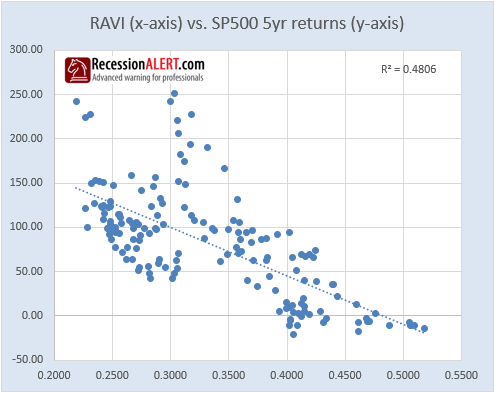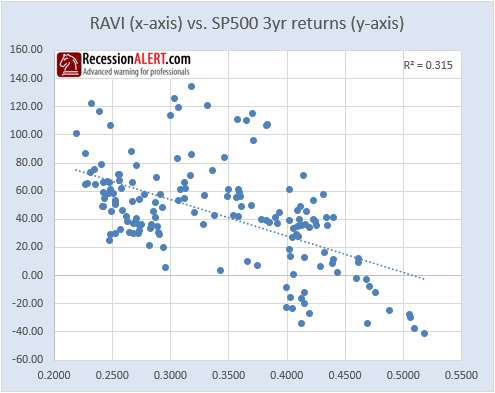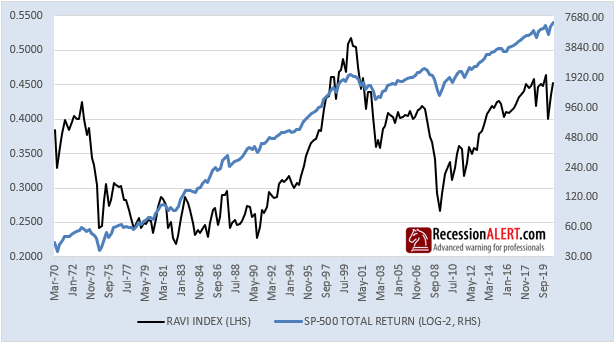There are many metrics currently being touted that demonstrate the stock market is dangerously overvalued. Many respectable models are even forecasting double digit negative returns for the US stock market over the next 10 years. In this research note we look at our RecessionALERT Valuation Index (RAVI) and how to interpret what it is currently saying about stock market valuations.
The RecessionALERT Valuation Index (RAVI) examines 10-year cyclically adjusted trailing SP-500 earnings, the SP-500 index level, total stock market capitalization, Gross Domestic Product, total SP-500 corporate liabilities, household debt, Federal government debt, state and local government debt, total SP-500 corporate net-worth and percentage of investors allocation to stocks versus cash and bonds to determine 10, 5, 3, 2 and 1 year forecasts for the SP-500 Total Return Index.
Interestingly, the current RAVI levels, whilst more elevated than the 2008 housing bubble top, have still not exceeded the 1999 dot.com bubble top.
The long-term historical accuracy of many of these types of robust models are not to be sniffed at. Naturally, as with most robust models, the most accurate RAVI forecasts happen at the long-term horizons, (in our case 10-years with some models being better at 12 years). This is depicted below where we regress the RAVI index in the above chart to subsequent 10-year SP500 Total Returns:

This shows that the RAVI can explain 86.4% of the SP500 10-year total returns into the future. The actual correlation is depicted on the left whilst the 10-year forecasts generated by the regression model together with the actual achieved 10-year total returns are shown on the right chart. At the last print, 3Q-2020, we are showing a 28.6% return over the ensuing decade, or roughly 2.5% compounded per annum.
Note how even a high statistical correlation can have the forecasted and actuals drifting from time to time, the period from 1988-1991 being a case in point. We firmly believe that the epic and unprecedented stimulus and money printing we are witnessing on a global scale now is inflating many bubbles simultaneously, namely bonds, stocks, junk debt, commodities, oil, crypto and housing to name a few. This is going to make these valuation models undershoot the actual achieved returns for a while – in other words, the stock market is going to remain overvalued and perhaps become even more over-valued in the short to medium term. But in the end, the actuals and the forecasted will mean-revert to maintain long-term correlations.
Our thesis is that while liquidity (central bank interventions, negative interest rates and shock-and-awe money supply growth) is omnipresent, you give the asset markets the benefit of the doubt. Yes, we’re embarrassed to say it, but its the old “Don’t fight the Fed” mantra. You could of course choose to not accept the valuation risk and step off the treadmill, but you are likely to be surprised by just how long the imbalances and central bank determination can persist and in all likelihood will suffer not-insignificant career-risk as returns in the bubble assets continue their inevitable upward march whilst you are sitting in low to negative yielding assets.
This does not mean you throw caution into the wind. The valuation models are good at quantifying your risk, but as with all bubbles the timing of that risk event is notoriously hard. We will deal with the quantifying of your risk separately to the timing of the event.
INCREDIBLE OFFER : Get 50% discount off our annual PRO Subscription, PLUS order before 1 December and get a second year completely FREE. Get your discount HERE
1.Quantifying Shorter term risk
Let us first try and quantify our current valuation risk. The reason we think this is important is that it will give us a discrete measurement to tell us how important it will be to determine the timing (which is more complicated). If the risk is low, the timing becomes less important, and it becomes easier to mitigate the risk, since we will know exactly how much small downside we potentially face. If the risk is high (large potential short term horizon losses) then we can again choose more aggressive risk mitigation matched to the size of the potential loss.
We know from the first chart above that 10-year returns from 3Q-2020 are very low at 28.6%, or 2.5% per annum. That’s enough to put anyone off equity investing, but the problem is that the path to that 28.6% return is unknown. It could be another 50% rally over the next 2 years with declines over the ensuing 8. To get a better feel for our risk we need to narrow the time frames down to shorter intervals, without compromising too much on correlations which may affect accuracy.
Let us try and change our time horizon from 10 to 5 years. If we regress the RAVI index to 5-year subsequent total returns (as opposed to 10) on the SP500 we get the following:

This is not going to be good enough, as the correlation (although not inconsequential) is simply too low to render it useful enough. So we are going to try another approach. We know the 10-year horizon forecasts are solid with high correlations. To derive a 5 year ahead forecast, we go back in time 5-years and see what the 10-year forecast was at that time in the past. We then look at the SP500 gains achieved during the last 5-years. We can then deduce what future 5-year returns will have to be by calculating the remaining gains/losses the SP500 needs to make to ensure that the target implied by the 10-year forecast from 5-years ago is ultimately met. We can generalize this methodology as summarized below:
The methodology starts with the accurate 10 year return forecasts (r-square > 0.86). To derive a (10-x) year ahead forecast (C) at time t=now, we go back in time x-years and see what the 10-year forecast was (A). We then look at the SP500 gains achieved during the last x-years (B). We can then deduce what C will need to be by calculating the remaining gains/losses the SP500 needs to make to ensure that the target A implied by the 10-year forecast from x-years ago is ultimately met.

Using this methodology to impute 5-year ahead returns for the SP500, we arrive at the following stunning results:

Incredibly, we have halved the forecast look-ahead period and only marginally sacrificed forecast accuracy. So now we can deduce that the 5-years ahead are going to deliver worse returns (0.67% per annum) than the 5 years following (since we know 10-year returns are forecast at 2.5% per annum from the 2nd chart in this research note.)
Emboldened by these promising results, let us reduce our look-ahead horizon to 3 years. A straight regression between the RAVI index and subsequent 3-year SP500 returns yields the following (to be expected) low correlations, which are again of no real practical use for short-term forecasts:

Again, we use the trick of going back in time and using x=7 in the proposed formula. We go back in time 7-years and see what the (presumably accurate) 10-year forecast was (A). We then look at the SP500 gains achieved during the last 7-years (B). We can then deduce what the next 3 years return C will need to be by calculating the remaining gains/losses the SP500 needs to make to ensure that the target A implied by the 10-year forecast from 7-years ago is ultimately met:

Again, the proposed methodology literally doubles the correlation of the straight regression and whilst we are starting to give up more accuracy here ( r-square reduces from 0.8 in 5-year forecast to 0.68 in the 3-year forecast) it is still high enough to prove practically useful. Additionally the model seems to suggest that most of the pain over the next 5 years is likely to come from the next 3 years than the following two, since the 5-year model was forecasting 0.67% per annum where the 3-year forecast is suggesting -2.4% per annum.
There is another interesting observation to be made here – the last two bear markets and last 3 recessions shortly (2-3 quarters) followed after the 3-year stock market forecasts dipped into negative territory. Given the 1-quarter lag in the data, we have an interesting result that a stock market valuation model seems to also serve as a medium term (1-2 quarters) recession indicator.
Here are the results of the modified 2-year forecast model which shows an r-square correlation of 0.56 versus the straight regression method which yields a lowly 0.24 correlation:

Yet again the modified method more than doubles the correlation of the straight regression. Whilst one might start getting nervous about basing investment decisions off something with a r-square of 0.56, we still think the result is pretty remarkable for such a short-term horizon. Let us put it this way – in over two decades of relentlessly hunting any and all manner of methods and metrics to regress onto short-term future stock market returns, we have never seen anything that comes this close consistently over a long-term horizon and multiple business cycles.
Whilst the individual quarter to quarter differentials between the 3-year forecasts and the actuals do sometimes get rather wide (as is to be expected from something with an r-square of 0.56) there is nonetheless some utility in these short-run forecasts, especially if one focuses on the trend and sign as opposed to actual values.
To wit, when this indicator starts getting close to zero it implies stock market valuations are getting dangerous (either because fundamentals are deteriorating or because the stock market has got ahead of itself, or a combination thereof) and if we switch to negative forecasts this is a sure sign of an impending recession and/or bear market. Alternatively, historical periods of time when forecasts are above 40 have also yielded outsized rewards for investors, as they imply that valuations are extremely low which almost always leads to outsized stock market returns.
In Part-2 of this series we will examine how to construct 1-year ahead forecasts to achieve correlation accuracies comparable to those of the 2-year ahead forecasts, and how this can be used to issue macroeconomic buy and sell signals on the US stock market as well as provide daily measurement of short-term (1 year) potential downside stock market risk.
Note to subscribers:
Paid subscribers can obtain the detailed quarterly RAVI PDF report from the REPORTS section of the website, under the MARKETS tab.
They can also view daily updated measurement of near-term stock market risk (potential 1-year upside/downside to fair value) in the Dashboard in the RAVI FORECASTS tab.
INCREDIBLE OFFER : Get 50% discount off our annual PRO Subscription, PLUS order before 1 December and get a second year completely FREE. Get your discount HERE


Comments are closed.